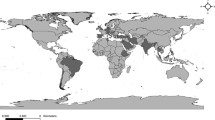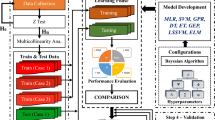Abstract
The unconfined compressive strength (UCS) of rocks, one fundamental parameter, is widely used in geotechnical engineering. Direct determination of the UCS involves expensive, time-consuming and destructive laboratory tests. These tests sometimes are difficult to be prepared for cracked rocks. In this way, indirect estimation of the UCS of rocks is widely discussed for simplicity and non-destructivity. Conventional methods for indirect estimation of the UCS of rocks are based on regression analysis which has poor accuracy or generalization ability. This paper presents the extreme learning machine (ELM) for indirect estimation of the UCS of rocks according to the correlated indexes including the mineral composition (calcite, clay, quartz, opaque minerals and biotile), specific density, dry unit weight, total porosity, effective porosity, slake durability index (fourth cycle), P-wave velocity in dry samples and in the solid part of the sample. The correlation between the UCS of rocks and each related index is studied by linear regression analysis. Based on this, the ELM approach is implemented for estimation of the UCS of rocks by comparison with other neural networks and the support vector machines (SVM). Also, parameter sensitivity is investigated on the predictive performance of the ELM by two target functions. The results turn out that the ELM is advantageous to the mentioned neural networks and the SVM in the estimation of the UCS of rocks. The ELM performs fast and has good generalization ability. It is a potential robust method for approaching complex, nonlinear problems in geotechnical engineering.












Similar content being viewed by others
References
Alvarez Grima M, Babuška R (1999) Fuzzy model for the prediction of unconfined compressive strength of rock samples. Int J Rock Mech Min Sci 36(3):339–349
ASTM (1984) Standard test method for unconfined compressive strength of intacot rock core specimens. Soil and rock building stones: Annual book of ASTM standards 4.08. ASTM, Philadelphia
Basu A, Kamran M (2010) Point load test on schistose rocks and its applicability in predicting uniaxial compressive strength. Int J Rock Mech Min Sci 47(5):823–828
Beckett CTS, Hall MR, Augarde CE (2013) Macrostructural changes in compacted earthen construction materials under loading. Acta Geotech 8(4):423–438
Bieniawski ZT (1975) Point load test in geotechnical practice. Eng Geol 9(1):1–11
Bieniawski ZT, Bernede MJ (1979) Suggested methods for determining the uniaxial compressive strength and deformability of rock materials: part 1. Suggested method for determining deformability of rock materials in uniaxial compression. Int J Rock Mech Min Sci Geomech Abstr 16(2):138–140
Buyuksagis IS, Goktan RM (2007) The effect of Schmidt hammer type on uniaxial compressive strength prediction of rock. Int J Rock Mech Min Sci 44(2):299–307
Cargill JS, Shakoor A (1990) Evaluation of empirical methods for measuring the uniaxial compressive strength of rock. Int J Rock Mech Min Sci Geomech Abstr 27(6):495–503
Ceryan N, Okkan U, Kesimal A (2012) Application of generalized regression neural networks in predicting the unconfined compressive strength of carbonate rocks. Rock Mech Rock Eng 45:1055–1072
Cevik A, Sezer EA, Cabalar AF, Gokceoglu C (2011) Modeling of the uniaxial compressive strength of some clay-bearing rocks using neural network. Appl Soft Comput 11(2):2587–2594
Chau KT, Wong RHC (1996) Uniaxial compressive strength and point load strength of rocks. Int J Rock Mech Min Sci Geomech Abstr 33(2):183–188
Cristelo N, Glendinning S, Fernandes L, Pinto A (2013) Effects of alkaline-activated fly ash and Portland cement on soft soil stabilisation. Acta Geotech 8(4):395–405
D’Andrea DV, Fisher RL, Fogelson DE (1964) Prediction of compression strength from other rock properties. Colo Sch Mines Q 59(4b):623–640
Deere DU, Miller RP (1966) Engineering classification and index properties for intact rock. Technical report. Air Force Weapons Lab, Kirtland Base, New Mexico
Dehghan S, Sattari G, Chehreh Chelgani S, Aliabadi MA (2010) Prediction of uniaxial compressive strength and modulus of elasticity for travertine samples using regression and artificial neural networks. Min Sci Technol (China) 20(1):41–46
Dinçer İ, Acar A, Ural S (2008) Estimation of strength and deformation properties of quaternary caliche deposits. Bull Eng Geol Environ 67(3):353–366. doi:10.1007/s10064-008-0146-1
Fener M, Kahraman S, Bilgil A, Gunaydin O (2005) A comparative evaluation of indirect methods to estimate the compressive strength of rocks. Rock Mech Rock Eng 38(4):329–343
Gokceoglu C (2002) A fuzzy triangular chart to predict the uniaxial compressive strength of the Ankara agglomerates from their petrographic composition. Eng Geol 66(1–2):39–51
Gokceoglu C, Zorlu K (2004) A fuzzy model to predict the uniaxial compressive strength and the modulus of elasticity of a problematic rock. Eng Appl Artif Intell 17(1):61–72
Grasso P, Xu S, Mahtab A (1992) Problems and promises of index testing of rocks. In: 33rd US symposium on rock mechanics, Sante Fe, Balkema, Rotterdam, pp 879–888
Hassani FP, Scoble MJJ, Whittaker BN (1980) Application of point-load index test to strength determination of rock and proposals fornew size-correction chart. In: Summers DA (ed) Proceedings of the 21st US symposium on rock mechanics, Rolla, Missouri, pp 543–554
Hobbs DW (1964) A simple method for assessing the uniaxial compressive strength of rock. Int J Rock Mech Min Sci Geomech Abstr 1(1):5–15
Horata P, Chiewchanwattana S, Sunat K (2013) Robust extreme learning machine. Neurocomputing 102:31–44
Huang G-B, Zhu Q-Y, Siew C-K (2006) Extreme learning machine: theory and applications. Neurocomputing 70(1–3):489–501
Huang GB, Wang DH, Lan Y (2011) Extreme learning machines: a survey. Int J Mach Learn Cybern 2(2):107–122
ISRM (1981) Rock characterization, testing and monitoring—ISRM suggested methods. Pergamon, Oxford
ISRM (2007) The complete ISRM suggested methods for rock characterization, testing and monitoring: 1974–2006. Suggested methods prepared by the commission on testing methods. ISRM Turkish National Group, Ankara
Joag AP, Lele VS (1981) Statistical prediction formula for compressive strength of a rock: Rock Mech, V13, N4, March 1981, P215–220. Int J Rock Mech Min Sci Geomech Abstr 18(5):86
Kahraman S (2001) Evaluation of simple methods for assessing the uniaxial compressive strength of rock. Int J Rock Mech Min Sci 38(7):981–994
Karakus M, Tutmez B (2006) Fuzzy and multiple regression modelling for evaluation of intact rock strength based on point load, Schmidt hammer and sonic velocity. Rock Mech Rock Eng 39(1):45–57
Karakus M, Kumral M, Kilic O (2005) Predicting elastic properties of intact rocks from index tests using multiple regression modelling. Int J Rock Mech Min Sci 42(2):323–330
Koncagül EC, Santi PM (1999) Predicting the unconfined compressive strength of the Breathitt shale using slake durability, shore hardness and rock structural properties. Int J Rock Mech Min Sci 36(2):139–153
Leite MH, Ferland F (2001) Determination of unconfined compressive strength and Young’s modulus of porous materials by indentation tests. Eng Geol 59(3–4):267–280
Liu Z, Shao J, Xu W, Shi C (2013) Estimation of elasticity of porous rock based on mineral composition and microstructure. Adv Mater Sci Eng 2013:1–10. doi:10.1155/2013/512727
Martínez-Martínez JM, Escandell-Montero P, Soria-Olivas E, Martín-Guerrero JD, Magdalena-Benedito R, Gómez-Sanchis J (2011) Regularized extreme learning machine for regression problems. Neurocomputing 74(17):3716–3721
Meulenkamp F, Grima MA (1999) Application of neural networks for the prediction of the unconfined compressive strength (UCS) from Equotip hardness. Int J Rock Mech Min Sci 36(1):29–39
Moomivand H (2011) Development of a new method for estimating the indirect uniaxial compressive strength of rock using Schmidt hammer. BHM Berg- Huettenmaenn Monatsh 156(4):142–146
Myrvang AM (1993) Estimation of in situ compressive strength of rocks from in situ rock stress measurements in highly stressed rock structures. Paper presented at the 7th ISRM international congress on rock mechanics, Aachen
Palchik V, Hatzor YH (2004) The influence of porosity on tensile and compressive strength of porous chalk. Rock Mech Rock Eng 37(4):331–341
Püspöki Z, Szabó S, Demeter G, Szalai K, McIntosh RW, Vincze L, Németh G, Kovács I (2005) The statistical relationship between unconfined compressive strengths and the frequency distributions of slope gradients—a case study in northern Hungary. Geomorphology 71(3–4):424–436
Quane SL, Russel JK (2003) Rock strength as a metric of welding intensity in pyroclastic deposits. Eur J Mineral 15:855–864
Rabbani E, Sharif F, Koolivand Salooki M, Moradzadeh A (2012) Application of neural network technique for prediction of uniaxial compressive strength using reservoir formation properties. Int J Rock Mech Min Sci 56:100–111
Rajabzadeh MA, Moosavinasab Z, Rakhshandehroo G (2012) Effects of rock classes and porosity on the relation between uniaxial compressive strength and some rock properties for carbonate rocks. Rock Mech Rock Eng 45(1):113–122
Rajesh Kumar B, Vardhan H, Govindaraj M, Vijay GS (2013) Regression analysis and ANN models to predict rock properties from sound levels produced during drilling. Int J Rock Mech Min Sci 58:61–72
Rezaei M, Majdi A, Monjezi M (2014) An intelligent approach to predict unconfined compressive strength of rock surrounding access tunnels in longwall coal mining. Neural Comput Appl 24(1):233–241
Sabatakakis N, Koukis G, Tsiambaos G, Papanakli S (2008) Index properties and strength variation controlled by microstructure for sedimentary rocks. Eng Geol 97(1–2):80–90
Singh DP (1981) Determination of some engineering properties of weak rocks. In: International symposium on weak rock, Tokyo, pp 21–24
Singh R, Vishal V, Singh T, Ranjith P (2013) A comparative study of generalized regression neural network approach and adaptive neuro-fuzzy inference systems for prediction of unconfined compressive strength of rocks. Neural Comput Appl 23(2):499–506
Sonmez H, Tuncay E, Gokceoglu C (2004) Models to predict the uniaxial compressive strength and the modulus of elasticity for Ankara agglomerate. Int J Rock Mech Min Sci 41(5):717–729
Tiryaki B (2008) Predicting intact rock strength for mechanical excavation using multivariate statistics, artificial neural networks, and regression trees. Eng Geol 99(1–2):51–60
Tsiambaos G, Sabatakakis N (2004) Considerations on strength of intact sedimentary rocks. Eng Geol 72(3–4):261–273
Tsidzi KEN (1991) Point load-uniaxial compressive strength correlation. In: 7th ISRM congress, Aachen, Germany, pp 637–639
Vallejo LE, Welsh RA, Robinson MK (1989) Correlation between unconfined compressive and point load strength for Appalachian rocks. In: 30th US symposium on rock mechanics, Morgantown, pp 461–468
Vernik L, Bruno M, Bovberg C (1993) Empirical relations between compressive strength and porosity of siliciclastic rocks. Int J Rock Mech Min Sci Geomech Abstr 30(7):677–680
Wang X, Chen A, Feng H (2011) Upper integral network with extreme learning mechanism. Neurocomputing 74(16):2520–2525
Yasar E, Erdogan Y (2004) Correlating sound velocity with the density, compressive strength and Young’s modulus of carbonate rocks. Int J Rock Mech Min Sci 41(5):871–875
Yesiloglu-Gultekin N, Sezer EA, Gokceoglu C, Bayhan H (2013) An application of adaptive neuro fuzzy inference system for estimating the uniaxial compressive strength of certain granitic rocks from their mineral contents. Expert Syst Appl 40(3):921–928
Yeu CWT, Lim MH, Huang GB, Agarwal A, Ong YS (2006) A new machine learning paradigm for terrain reconstruction. IEEE Geosci Remote Sens Lett 3(3):382–386
Yilmaz I (2009) A new testing method for indirect determination of the unconfined compressive strength of rocks. Int J Rock Mech Min Sci 46(8):1349–1357
Yilmaz I, Kaynar O (2011) Multiple regression, ANN (RBF, MLP) and ANFIS models for prediction of swell potential of clayey soils. Expert Syst Appl 38(5):5958–5966
Yılmaz I, Sendır H (2002) Correlation of Schmidt hardness with unconfined compressive strength and Young’s modulus in gypsum from Sivas (Turkey). Eng Geol 66(3–4):211–219
Yilmaz I, Yuksek AG (2008) Technical note: an example of artificial neural network (ANN) application for indirect estimation of rock parameters. Rock Mech Rock Eng 41(5):781–795
Zhu Q-Y, Qin AK, Suganthan PN, Huang G-B (2005) Evolutionary extreme learning machine. Pattern Recognit 38(10):1759–1763
Zong W, Huang G-B, Chen Y (2013) Weighted extreme learning machine for imbalance learning. Neurocomputing 101:229–242
Zorlu K, Gokceoglu C, Ocakoglu F, Nefeslioglu HA, Acikalin S (2008) Prediction of uniaxial compressive strength of sandstones using petrography-based models. Eng Geol 96(3–4):141–158
Acknowledgments
Financial support from China 973 Program for Key Basic Research Project (No. 2011CB013504) and China Natural Science Foundation (No. 11272114) is gratefully acknowledged. The authors also thank the Editors and the anonymous reviewers for their constructive comments.
Author information
Authors and Affiliations
Corresponding author
Rights and permissions
About this article
Cite this article
Liu, Z., Shao, J., Xu, W. et al. Indirect estimation of unconfined compressive strength of carbonate rocks using extreme learning machine. Acta Geotech. 10, 651–663 (2015). https://doi.org/10.1007/s11440-014-0316-1
Received:
Accepted:
Published:
Issue Date:
DOI: https://doi.org/10.1007/s11440-014-0316-1




